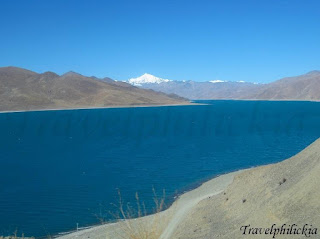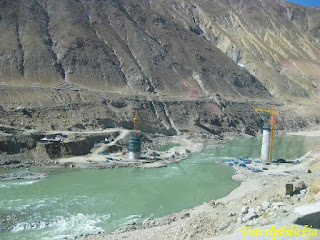After breakfast, we checked out from the hotel and then set off at about 8 am to Yamdrok Lake.
Sceneries along the route
Amazing mountain ridges of arid steppe with clear sky was spotted along the route (photos below).




After about an hour's drive, we reached Yamdrok Lake.
Yamdrok Lake (羊卓雍錯)
Yamdrok Lake, also known as Yamdrok Yumtso, is a freshwater lake located around 90-km west of Gyantse and one of the three largest sacred lake in Tibet. The other two sacred lakes are Manasarovar Lake (瑪旁雍錯) and Namtso Lake (纳木错).
The lake, 638 square meters in area with an average of 30-meters deep, is a fan-shaped spreading to the south but narrowing up to the north. It is surrounded by many snow-capped mountains and fed by numerous small streams (photos below).

 Yamdrok Lake is famous for its incredible turquoise color. Its water is rich in minerals and crystal clear with low sediment that give the lake its color. The lake can range from light turquoise in direct sunlight to the deep rich blue in cloudy weather (photos below).
Yamdrok Lake is famous for its incredible turquoise color. Its water is rich in minerals and crystal clear with low sediment that give the lake its color. The lake can range from light turquoise in direct sunlight to the deep rich blue in cloudy weather (photos below).




Towards the end of the ride before lunch, we happened to see typical houses of local peasants (photos below). Depending on the availability of the materials, Tibetan houses are built with more wood for those living near forest, or more stones for those living near mountains. Usually, the walls are one meter thick and built with stones. The roof is built with scores of tree trunks, and then covered with a thick layer of clay.

 Lunch
LunchWe then reached Yudu Restaurant (渝都饭店) for lunch (left photo below). While walking towards our lunch area, interestingly we saw chinese-style sausages hanging high to dry at a corner near the kitchen (right photo below).

 A total of six dishes were served in this lunch, together with rice (photos below).
A total of six dishes were served in this lunch, together with rice (photos below).






Snow-capped mountains could be seen from the highway before reaching the glacier (photos below).

 Karola Glacier originates from Mount Noijin Kangsang of 7191-meters height and it is one of the four holy mountains of Tibet.
Karola Glacier originates from Mount Noijin Kangsang of 7191-meters height and it is one of the four holy mountains of Tibet.

The viewing point is just off the highway which allows visitors to easily get a close-up view of the magnificent glacier (photo below). The glacier is at an elevation of over 5,000-meters; thus visitors should pace slowly while walking or climbing to avoid high altitude sickness.
Gyantse (江孜)
Gyantse is a town located in Gyantse County of Tibet. It used to be historically third largest town but now it is only one of the ten larger Tibetan cities. Gyantse is 3,977-meters above sea level and located 254-km southwest of Lhasa.
Gyantse Dzong (江孜宗山)
Gyantse Dzong is one of the best-preserved fortresses that perched high above the town of Gyantse on a huge spur of greyish-brown rock (photos below). Gyantse is referred to by Chinese government as the "Hero City" because of the determined resistance displayed by the Tibetans defenders against a far superior invading British troops in 1904. To commemorate the 100th anniversary of this fight, a "Monument to the Heroes of Gyantse Dzong" was erected at the square in 2004.

 Baiju Temple (白居寺)
Baiju Temple (白居寺)Baiju Temple, also known as "Palcho Monastery" or "Pelkor Chode Monastery", is the main monastery in Gyantse which consists of several structures in Han, Tibetan and Nepali architectures which are surrounded by high red walls (photos below). It is the one of the only monasteries that incorporates teachings from multiple sects of Tibetan Buddhism.

 Admission ticket was given to us prior to entering the temple (photo below).
Admission ticket was given to us prior to entering the temple (photo below).
Zhacang (扎仓) is the residential quarters located within the temple area (left photo below). Tsulaklakang (措钦大殿) is the main temple consists of three floors where the main deity is the 8-meters tall bronze statue of Shakyamuni Buddha (right photo below).

 The most famous structure is the Kumbum stupa (吉祥多门塔) which is 32-meters high with nine floors or tiers, and each tier has unique cells (photos below). Altogether there are 108 cells and 76 chapels where each chapel contains a variety of stunning Buddhist statues. With this expansive statue collection, this Kumbum is sometimes referred to as the "Hundred Thousand Buddha Stupa".
The most famous structure is the Kumbum stupa (吉祥多门塔) which is 32-meters high with nine floors or tiers, and each tier has unique cells (photos below). Altogether there are 108 cells and 76 chapels where each chapel contains a variety of stunning Buddhist statues. With this expansive statue collection, this Kumbum is sometimes referred to as the "Hundred Thousand Buddha Stupa".

 After the visit of the monastery, we then reached Shigatse after an hour's drive.
After the visit of the monastery, we then reached Shigatse after an hour's drive.Shigatse (日喀则)
Shigatse is a prefecture-level city and second largest city in Tibet. It is located about 280-km southwest of Lhasa.
Tashi Lhunpo Monastery (扎什伦布寺)
Tashi Lhunpo Monastery is founded in 1447 by first Dalai Lama and it is traditional monastic seat of successive Panchen Lamas (photos below). Panchen Lama is the second most important Lama in Tibet after the Dalai Lama.

 The ticket booth is located at the monastery's main southern entrance. Admission ticket was then handed to us by our tour guide prior to the entrance (photo below).
The ticket booth is located at the monastery's main southern entrance. Admission ticket was then handed to us by our tour guide prior to the entrance (photo below).
From the entrance to the monastery, a grand view of the whole monastery can be seen. Following photo illustrate the position of its four prominent buildings.
 To the right of the quarters and on higher ground is the 32-meters tall Festival Thangka Wall, which is used for hanging the massive and colourful Thangkas during festivals (left photo below). Above the white monastic quarters is a crowd of ochre buildings topped with gold which are the tombs of the past Panchen Lamas (right photo below).
To the right of the quarters and on higher ground is the 32-meters tall Festival Thangka Wall, which is used for hanging the massive and colourful Thangkas during festivals (left photo below). Above the white monastic quarters is a crowd of ochre buildings topped with gold which are the tombs of the past Panchen Lamas (right photo below).

 The Monastery withstood well during the Cultural Revolution compared to other monasteries in Tibet. However, many relics, statues and paintings were lost or destroyed. Among the lost items were the relics from 5th to 9th Panchen Lamas Tomb Stupas where the Red Guards threw them into the river. The 10th Panchen Lama began the construction of a new stupa to house and honour his predecessors and it was finally consecrated in 1989.
The Monastery withstood well during the Cultural Revolution compared to other monasteries in Tibet. However, many relics, statues and paintings were lost or destroyed. Among the lost items were the relics from 5th to 9th Panchen Lamas Tomb Stupas where the Red Guards threw them into the river. The 10th Panchen Lama began the construction of a new stupa to house and honour his predecessors and it was finally consecrated in 1989.The Tomb Stupas of the Fourth Panchen Lama, Kundun Lhakhang (1567 - 1662), remined untouched during the Cultural Revolution. The 11-meters funerary chörten is inlaid with semi-precious stones and contains 85-kg of gold (left photo below).
The tomb of the Tenth Panchen Lama, Serdung Sisum Namgyel (1938 - 1989), is a dazzling gold-plated funeral chörten which took 3 years of construction. The 11.55-meters high stupa is gold-wrapped and also inlaid with precious jewels and diamonds (right photo below).


The Chapel of Maitreya or Jampa is probably the most impressive sight in Tashi Lhunpo Monastery. Built in 1914, it is a 30-meters high of five storey chapel which houses the Jampa or Maitreya, also known as the Future Buddha (photos below).


The most eye-catching is the world's largest and tallest glided bronze statue of Maitreya Buddha. Sitting on a 3.8-meters high lotus pedestal, the Buddha statue is 26.2-meters high and with shoulder width of 11.5-meters (photos below). It took 110 craftsmen in 1914 to finish in four years with extreme cost including over 300-kg of gold and brass, and numerous diamonds, pearls, amber, coral, pine otoliths inlaid and other precious decorations.


Dinner
We then had dinner at Honghe valley Restaurant (红河谷餐厅) (left photo below). Total of six dishes including a vegetable soup were served together with rice (right photo below).

 After dinner, we then checked in our YangTse Hotel at Shigatse.
After dinner, we then checked in our YangTse Hotel at Shigatse.As it was still early at about 6.30 pm, we decided to walk across the street from our hotel (left photo below) to purchase some snacks from the local grocery store (right photo below).


We then went back to hotel for an early rest.
Day Eight
After breakfast, we checked out from the YangTse Hotel and started our route back to Lhasa at about 9 am. It was a long journey and the route traveled was along Yarlong Tseangpo River.
Yarlong Tseangpo River (雅鲁藏布江)
Yarlong Tseangpo River is the name to the upper stream of Brahmaputra River which starts from Tibet and flows downstream to India and Bangladesh. Yarlong Tseangpo River is the longest river in Tibet with a length of 2,840-km and fifth longest in China. It is the highest river in the world with an average altitude of over 4,000-meters.
Stunning scenery of the Yarlong Tseangpo Valley could be seen during the route (photos below).





 Glad that we bought snacks the day before as I could satisfy my hunger from the light breakfast taken at YangTse Hotel (photos below).
Glad that we bought snacks the day before as I could satisfy my hunger from the light breakfast taken at YangTse Hotel (photos below).

Two separate herd of goats almost blocked our vehicle during the route (photos below).



 Construction of Lhasa-Shigatse railway could be seen (photos below). This new extension of the railway is expected to be completed in 2014.
Construction of Lhasa-Shigatse railway could be seen (photos below). This new extension of the railway is expected to be completed in 2014.



 Lunch
LunchWe then had our lunch at 香辣川菜 restaurant (left photo below). It was rather innovative to see the paper cup holders for hot tea (right photo below).

 A total of four dishes including soup were served during this meal (photos below).
A total of four dishes including soup were served during this meal (photos below).

 Retail Store Visit
Retail Store VisitAfter a long drive we reached Lhasa at about 2 pm. As there was no itinerary for the day, our tour guide then brought us to the Tibetan Medicinal and Cultural exhibition (藏医药文化陈列馆) for a visit (left photo below). We didn't buy any as we are not familiar with any of the Tibetan medicine.
Dinner
Had our early dinner at the usual Xingdada Cellar (兴达大酒庄) Restaurant. A total of five dishes including a vegetarian soup were served (right photo below).

 After dinner we then checked in to Jiangsu Shengtaiyuan Hotel and had an early rest.
After dinner we then checked in to Jiangsu Shengtaiyuan Hotel and had an early rest.
 Posts RSS
Posts RSS





